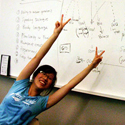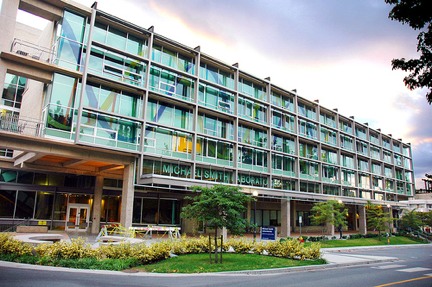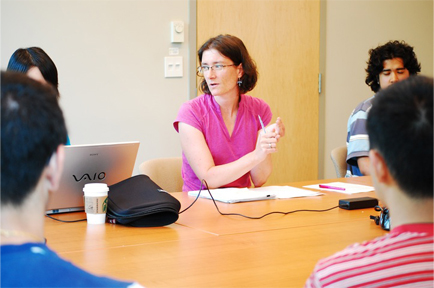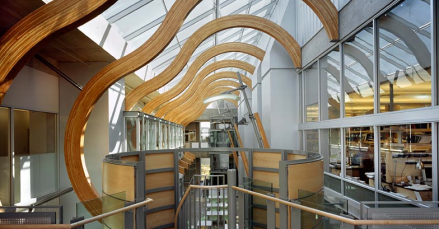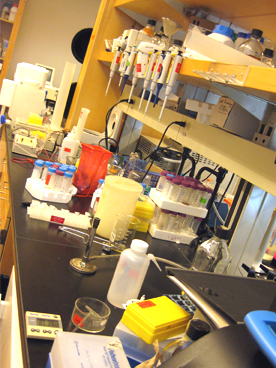Team:British Columbia/Notebook/Brainstorming
From 2011.igem.org
| (17 intermediate revisions not shown) | |||
| Line 3: | Line 3: | ||
<head> | <head> | ||
<style type="text/css"> | <style type="text/css"> | ||
| - | |||
| - | |||
| - | |||
</style> | </style> | ||
<body> | <body> | ||
| - | <h2>Brainstroming & Introductions: Apr 12 - May 8</h2> | + | <style> |
| - | + | #bod {width:935px; float:left; background-color: white; margin-left: 15px; margin-top:10px;}</style> | |
| - | < | + | <div id="bod"> |
| - | + | <a name="brainstorm"><h2>Brainstroming & Introductions: Apr 12 - May 8</h2></a> | |
| + | </html> | ||
| + | [[File:Msl.jpg | frame | right | 200px | Michael Smith Laboratories]] | ||
A week after the UBC iGEM 2011 team was formed, we got together at the beautiful Michael Smith Laboratories (MSL) and brainstormed potential synthetic biology projects. These were some of the ideas and topics floating around: | A week after the UBC iGEM 2011 team was formed, we got together at the beautiful Michael Smith Laboratories (MSL) and brainstormed potential synthetic biology projects. These were some of the ideas and topics floating around: | ||
| - | *Optogenetics | + | *Optogenetics (for neuroscience) and phodopsin fusion proteins activated by light |
| + | *"Do it yourself" biology - ex. build PCR machine | ||
*Chemo-signalling (using antibodies as signals) | *Chemo-signalling (using antibodies as signals) | ||
*Re-routing networks (creating fusion proteins that make extra interactions to interfere with natural protein links) | *Re-routing networks (creating fusion proteins that make extra interactions to interfere with natural protein links) | ||
| + | *Plants that grow bulbs instead of being needed to be planted each year | ||
*Eradicating bed bugs | *Eradicating bed bugs | ||
*Eradicating pine beetles | *Eradicating pine beetles | ||
| - | *Tackling battery waste | + | *Tackling battery waste - new means to break down and recycle battery waste |
*Photo-dynamic inhibition (bacteria are killed by light) | *Photo-dynamic inhibition (bacteria are killed by light) | ||
| - | *Using bacteria to clean water | + | *Using bacteria to clean water (ex. from oil spills) |
*Using probiotics to tackle cholera | *Using probiotics to tackle cholera | ||
*Temperature-sensitive inteins | *Temperature-sensitive inteins | ||
| - | Each team member brought an idea home and did background research to determine how feasible these ideas were | + | Each team member brought an idea home (while final exams were going on!) and did background research to determine how feasible these ideas were. |
| - | <html><img src="http://upload.wikimedia.org/wikipedia/commons/f/f6/Vibrio_cholerae.jpg" height=180px> | + | <b>Bedbugs:</b> This is a major problem found in the downtown east side of Vancouver. We wanted to find a way to manipulate the pheromones released between a male and female bed bugs during mating and alternatively promote homosexual mating. We looked into means of signaling and how we could model it with Drosophilia. A neighboring university (SFU) is working with bed bugs already. |
| + | *<i>Problems:</i> It is difficult to work with bed bugs, Health Canada says it’s not a major health risk and the model organism would be Drosophila (must consider the size of DNA). | ||
| + | |||
| + | <b>Pine Beetle Infestation in B.C.:</b> The mountain pine beetle (MPB) is rapidly killing pine trees in B.C. Pine trees make up approximately 25% of loggable trees for B.C.’s logging industry. Huge environmental impacts will occur all over B.C. if this problem is not solved. | ||
| + | |||
| + | <b>Gulf Oil Spill:</b> We wanted to find a way to allow bacteria to make clean water, perform hydrocarbon degradation and clean the chemicals that were used to clean the Gulf oil spill | ||
| + | *<i>Problems:</i> We were not sure how to incorporate a kill mechanism after the bacteria cleaned up the oil. Also, we can’t really just dump drugs into the ocean. | ||
| + | |||
| + | <b>Cholera:</b> Many people were infected with Cholera after the earthquake in Haiti. Based on AB toxin binding and receptors on the host epithelium, we wanted to over express receptors for toxins/unhealthy particles on caulobacter (slimy coat). | ||
| + | *<i>Problem:</i> The natural receptors found on the epithelium probably have importance so inhibiting them is a bad idea. | ||
| + | |||
| + | <b>Bacteria that take up light:</b> We thought about using carotenoids to absorb lots of light and having bacteria that respond to different wavelengths. | ||
| + | *<i>Problem:</i> We were not sure if people would be willing to purchase a product that uses this (we would like to target skin diseases). | ||
| + | |||
| + | <b>Bulbs and Perennials:</b> We thought about trying to make plants that need to be planted each year to grow bulbs instead. This has not been done yet. | ||
| + | *<i>Problem:</i> UBC faculty says this problem is too ambitious and the gene’s that make bulbs is not really known yet. | ||
| + | |||
| + | We wanted to do something useful for either people and/or the environment. Additionally, we wanted to be realistic in terms of what we could achieve in one summer. Thus, we narrowed down our ideas to only two: | ||
| + | #cloning cholera receptors into probiotics and | ||
| + | #transforming microbes with pine beetle pheromones to gather and eradicate pine beetles. | ||
| + | |||
| + | |||
| + | <html><center><img src="http://upload.wikimedia.org/wikipedia/commons/f/f6/Vibrio_cholerae.jpg" height=180px> | ||
<img src="http://upload.wikimedia.org/wikipedia/commons/5/5e/Mt_Fraser_-_Pine_Beetle_Damage.JPG" height=180px> | <img src="http://upload.wikimedia.org/wikipedia/commons/5/5e/Mt_Fraser_-_Pine_Beetle_Damage.JPG" height=180px> | ||
| - | <p><font size=1>From left to right: an electron microscope image of <i>Vibrio cholera</i>, a view from Mount Fraser of the pine beetle infestation and dying red trees.</font></p> | + | <p><font size=1>From left to right: an electron microscope image of <i>Vibrio cholera</i>, a view from Mount Fraser of the pine beetle infestation and dying red trees.</font></p></center> |
</html> | </html> | ||
| + | |||
| + | <h2> Research Phase & Narrowing Down - May 9 - 11 </h2> | ||
Everyone was passionate about the pine beetle project because of the relevant applications to the forests of British Columbia. Furthermore, there is expertise close at home: the Bohlmann lab in the MSL. Team members from the 2010 iGEM team learnt that it was difficult to obtain resources and collaborate with scientists who were not in the same country. We decided to keep on doing more background reading to develop the project plan, as well as begin contacting researchers working in this field to see what they thought of our ideas. | Everyone was passionate about the pine beetle project because of the relevant applications to the forests of British Columbia. Furthermore, there is expertise close at home: the Bohlmann lab in the MSL. Team members from the 2010 iGEM team learnt that it was difficult to obtain resources and collaborate with scientists who were not in the same country. We decided to keep on doing more background reading to develop the project plan, as well as begin contacting researchers working in this field to see what they thought of our ideas. | ||
| Line 38: | Line 63: | ||
After a couple of days, the team met up to discuss the pine beetle project in more detail: the objectives, future applications/implications, parts/resources we required, the wet lab, modeling, and human practices components. | After a couple of days, the team met up to discuss the pine beetle project in more detail: the objectives, future applications/implications, parts/resources we required, the wet lab, modeling, and human practices components. | ||
| - | + | <h2> Training - May 9 - 13 </h2> | |
| - | [[File:joanneubcmeet.jpg]] | + | [[File:joanneubcmeet.jpg | frame | left | 100px | Joanne on iGEM Training]] |
| - | Dr. Joanne Fox began a week of iGEM laboratory training in AMBL, the teaching lab in the MSL. The training sessions ran from 10am-4pm. Joanne provided short lectures so everyone could understand the magic of cloning: using purification kits, performing CIP assays and ligations etc. We performed restriction digests and ligations of insert and vector components, which were transformed into bacteria and plated on agar. | + | Dr. Joanne Fox began a week of iGEM laboratory training in AMBL, the teaching lab in the MSL, and everyone was extremely thrilled to be finally starting some wetlab. The training sessions ran from 10am-4pm. Joanne provided short lectures so everyone could understand the magic of cloning: using purification kits, performing CIP assays and ligations etc. We performed restriction digests and ligations of insert and vector components, which were transformed into bacteria and plated on agar. |
In between experiments, Marianne and Vicki (returning team members) went over labeling etiquette, lab book organization and the 3-antibiotic method. | In between experiments, Marianne and Vicki (returning team members) went over labeling etiquette, lab book organization and the 3-antibiotic method. | ||
| Line 48: | Line 73: | ||
The team then did plate analysis and started cultures for plasmid preps. Not everyone had successful transformations (colonies on their plates), so some had to steal others' colonies to start the culture... | The team then did plate analysis and started cultures for plasmid preps. Not everyone had successful transformations (colonies on their plates), so some had to steal others' colonies to start the culture... | ||
| - | + | ||
| + | |||
| + | |||
| + | |||
| + | |||
| + | |||
| + | |||
| + | |||
| + | |||
| + | |||
| + | <h2> Monday Meetings </h2> | ||
Mondays are when we have our weekly open lab meetings where interested faculty as well as iGEM student club members attend to hear about our project and provide input. We presented our project proposal to our advisors and faculty: Joanne Fox, Leonard Foster, Phil Hieter, Joerg Bohlmann and Chris Keeling, who generously agreed to help us obtain our necessary wet lab components such as genes encoding monoterpene synthases. | Mondays are when we have our weekly open lab meetings where interested faculty as well as iGEM student club members attend to hear about our project and provide input. We presented our project proposal to our advisors and faculty: Joanne Fox, Leonard Foster, Phil Hieter, Joerg Bohlmann and Chris Keeling, who generously agreed to help us obtain our necessary wet lab components such as genes encoding monoterpene synthases. | ||
| - | + | <h2> First Social! - May 18</h2> | |
| - | + | We had our first iGEM team social = bonding time! We all went to the Indian Oven to have dinner (under Rafael's suggestion), discuss our project and watch a part of the hockey game (Go Canucks!). It was semi-productive in terms of project discussion. | |
| - | Before the week ended, we had our first modeling meeting at Blenz. Our modeling advisor, Shing provided guidance on the different modeling ideas we had: | + | [[File:canucksubc.jpg | frame | right | 20px]] |
| + | |||
| + | |||
| + | <h2> Modeling Meeting - May 23 </h2> | ||
| + | Before the week ended, we had our first modeling meeting at Blenz (a local coffee shop). Our modeling advisor, Shing provided guidance on the different modeling ideas we had: | ||
*Modeling monoterpene production by yeast | *Modeling monoterpene production by yeast | ||
*Using google Earth to predict the spread of the pine beetle infestation and the effects of a synthetic biology intervention | *Using google Earth to predict the spread of the pine beetle infestation and the effects of a synthetic biology intervention | ||
*Using synthase and transporter protein homologues to predict target specificity | *Using synthase and transporter protein homologues to predict target specificity | ||
| + | <br><br><br><br> | ||
| - | + | <h2> Project Tracks </h2> | |
| - | + | [[File:Ubcpoles.png | frame | left | 95px | Michael Smith Laboratories]] | |
| - | + | ||
| - | + | ||
Because Monday (the 23rd) was Victoria Day, we had our lab meeting on Tuesday. Prior to the meeting, Daisy presented Chris Keeling's 2011 Transcriptome Mining paper. We discussed the methods section and outlined the reagents, protocols and any equipment that we might need to characterize monoterpene synthases. Sam and Gurpal found papers from Greece and France that used variants of metabolic genes (mutant erg20-2, IDI1) to increase the yield of monoterpenes by yeast. | Because Monday (the 23rd) was Victoria Day, we had our lab meeting on Tuesday. Prior to the meeting, Daisy presented Chris Keeling's 2011 Transcriptome Mining paper. We discussed the methods section and outlined the reagents, protocols and any equipment that we might need to characterize monoterpene synthases. Sam and Gurpal found papers from Greece and France that used variants of metabolic genes (mutant erg20-2, IDI1) to increase the yield of monoterpenes by yeast. | ||
| Line 71: | Line 109: | ||
The team discussed possible sub-projects and came up with a "Synthase" track and an "Extra parts" track. Marianne, Vicki, Daisy, Jacob, and Joe will work on the "Synthase" track, each taking on a different synthase; Gurpal and Sam will be on the "Extra parts" track, liaising with the researchers in Greece and France to obtain the relevant plasmids/genes. Vicki took charge of the sponsorship package so everyone could begin contacting potential sponsors. | The team discussed possible sub-projects and came up with a "Synthase" track and an "Extra parts" track. Marianne, Vicki, Daisy, Jacob, and Joe will work on the "Synthase" track, each taking on a different synthase; Gurpal and Sam will be on the "Extra parts" track, liaising with the researchers in Greece and France to obtain the relevant plasmids/genes. Vicki took charge of the sponsorship package so everyone could begin contacting potential sponsors. | ||
| - | |||
| - | This week, we also finally secured a lab space (Thank you Ellis Lab!) and began moving equipment, unpacking, organizing and ordering supplies and reagents. | + | <h2> Finally - lab space! - May 26</h2> |
| + | [[File:ubcigemellislab.jpg | frame | left | 100px | Lab bench in the Ellis lab]] | ||
| + | |||
| + | This week, we also finally secured a lab space (Thank you Ellis Lab!) and began moving equipment, unpacking, organizing and ordering supplies and reagents. | ||
For our modeling project, Gurpal started working on the model of monoterpene production in yeast by drawing out the biological pathways involved. He found that Matlab would be the best program to use and went through the SimBiology Kit Tutorials. Jacob and Joe began research on how to create a model of the pine beetle infestation and started contacting relevant professors at UBC. | For our modeling project, Gurpal started working on the model of monoterpene production in yeast by drawing out the biological pathways involved. He found that Matlab would be the best program to use and went through the SimBiology Kit Tutorials. Jacob and Joe began research on how to create a model of the pine beetle infestation and started contacting relevant professors at UBC. | ||
| + | |||
| + | |||
| + | |||
| + | |||
| + | |||
| + | |||
| + | |||
| + | |||
| + | |||
| + | |||
| + | |||
| + | |||
| + | |||
| + | |||
| + | |||
| + | |||
| + | |||
| + | |||
| + | |||
| + | |||
| + | |||
| + | |||
| + | |||
| + | |||
| + | <html> | ||
| + | <a href="https://2011.igem.org/Team:British_Columbia/Notebook"><center><b>Back to the Notebook</b></center></a> | ||
Latest revision as of 23:10, 16 October 2011

 |
 |
 |
 |
 |
Brainstroming & Introductions: Apr 12 - May 8
A week after the UBC iGEM 2011 team was formed, we got together at the beautiful Michael Smith Laboratories (MSL) and brainstormed potential synthetic biology projects. These were some of the ideas and topics floating around:
- Optogenetics (for neuroscience) and phodopsin fusion proteins activated by light
- "Do it yourself" biology - ex. build PCR machine
- Chemo-signalling (using antibodies as signals)
- Re-routing networks (creating fusion proteins that make extra interactions to interfere with natural protein links)
- Plants that grow bulbs instead of being needed to be planted each year
- Eradicating bed bugs
- Eradicating pine beetles
- Tackling battery waste - new means to break down and recycle battery waste
- Photo-dynamic inhibition (bacteria are killed by light)
- Using bacteria to clean water (ex. from oil spills)
- Using probiotics to tackle cholera
- Temperature-sensitive inteins
Each team member brought an idea home (while final exams were going on!) and did background research to determine how feasible these ideas were.
Bedbugs: This is a major problem found in the downtown east side of Vancouver. We wanted to find a way to manipulate the pheromones released between a male and female bed bugs during mating and alternatively promote homosexual mating. We looked into means of signaling and how we could model it with Drosophilia. A neighboring university (SFU) is working with bed bugs already.
- Problems: It is difficult to work with bed bugs, Health Canada says it’s not a major health risk and the model organism would be Drosophila (must consider the size of DNA).
Pine Beetle Infestation in B.C.: The mountain pine beetle (MPB) is rapidly killing pine trees in B.C. Pine trees make up approximately 25% of loggable trees for B.C.’s logging industry. Huge environmental impacts will occur all over B.C. if this problem is not solved.
Gulf Oil Spill: We wanted to find a way to allow bacteria to make clean water, perform hydrocarbon degradation and clean the chemicals that were used to clean the Gulf oil spill
- Problems: We were not sure how to incorporate a kill mechanism after the bacteria cleaned up the oil. Also, we can’t really just dump drugs into the ocean.
Cholera: Many people were infected with Cholera after the earthquake in Haiti. Based on AB toxin binding and receptors on the host epithelium, we wanted to over express receptors for toxins/unhealthy particles on caulobacter (slimy coat).
- Problem: The natural receptors found on the epithelium probably have importance so inhibiting them is a bad idea.
Bacteria that take up light: We thought about using carotenoids to absorb lots of light and having bacteria that respond to different wavelengths.
- Problem: We were not sure if people would be willing to purchase a product that uses this (we would like to target skin diseases).
Bulbs and Perennials: We thought about trying to make plants that need to be planted each year to grow bulbs instead. This has not been done yet.
- Problem: UBC faculty says this problem is too ambitious and the gene’s that make bulbs is not really known yet.
We wanted to do something useful for either people and/or the environment. Additionally, we wanted to be realistic in terms of what we could achieve in one summer. Thus, we narrowed down our ideas to only two:
- cloning cholera receptors into probiotics and
- transforming microbes with pine beetle pheromones to gather and eradicate pine beetles.

From left to right: an electron microscope image of Vibrio cholera, a view from Mount Fraser of the pine beetle infestation and dying red trees.
Contents |
Research Phase & Narrowing Down - May 9 - 11
Everyone was passionate about the pine beetle project because of the relevant applications to the forests of British Columbia. Furthermore, there is expertise close at home: the Bohlmann lab in the MSL. Team members from the 2010 iGEM team learnt that it was difficult to obtain resources and collaborate with scientists who were not in the same country. We decided to keep on doing more background reading to develop the project plan, as well as begin contacting researchers working in this field to see what they thought of our ideas.
After a couple of days, the team met up to discuss the pine beetle project in more detail: the objectives, future applications/implications, parts/resources we required, the wet lab, modeling, and human practices components.
Training - May 9 - 13
Dr. Joanne Fox began a week of iGEM laboratory training in AMBL, the teaching lab in the MSL, and everyone was extremely thrilled to be finally starting some wetlab. The training sessions ran from 10am-4pm. Joanne provided short lectures so everyone could understand the magic of cloning: using purification kits, performing CIP assays and ligations etc. We performed restriction digests and ligations of insert and vector components, which were transformed into bacteria and plated on agar.
In between experiments, Marianne and Vicki (returning team members) went over labeling etiquette, lab book organization and the 3-antibiotic method.
The team then did plate analysis and started cultures for plasmid preps. Not everyone had successful transformations (colonies on their plates), so some had to steal others' colonies to start the culture...
Monday Meetings
Mondays are when we have our weekly open lab meetings where interested faculty as well as iGEM student club members attend to hear about our project and provide input. We presented our project proposal to our advisors and faculty: Joanne Fox, Leonard Foster, Phil Hieter, Joerg Bohlmann and Chris Keeling, who generously agreed to help us obtain our necessary wet lab components such as genes encoding monoterpene synthases.
First Social! - May 18
We had our first iGEM team social = bonding time! We all went to the Indian Oven to have dinner (under Rafael's suggestion), discuss our project and watch a part of the hockey game (Go Canucks!). It was semi-productive in terms of project discussion.
Modeling Meeting - May 23
Before the week ended, we had our first modeling meeting at Blenz (a local coffee shop). Our modeling advisor, Shing provided guidance on the different modeling ideas we had:
- Modeling monoterpene production by yeast
- Using google Earth to predict the spread of the pine beetle infestation and the effects of a synthetic biology intervention
- Using synthase and transporter protein homologues to predict target specificity
Project Tracks
Because Monday (the 23rd) was Victoria Day, we had our lab meeting on Tuesday. Prior to the meeting, Daisy presented Chris Keeling's 2011 Transcriptome Mining paper. We discussed the methods section and outlined the reagents, protocols and any equipment that we might need to characterize monoterpene synthases. Sam and Gurpal found papers from Greece and France that used variants of metabolic genes (mutant erg20-2, IDI1) to increase the yield of monoterpenes by yeast.
The team discussed possible sub-projects and came up with a "Synthase" track and an "Extra parts" track. Marianne, Vicki, Daisy, Jacob, and Joe will work on the "Synthase" track, each taking on a different synthase; Gurpal and Sam will be on the "Extra parts" track, liaising with the researchers in Greece and France to obtain the relevant plasmids/genes. Vicki took charge of the sponsorship package so everyone could begin contacting potential sponsors.
Finally - lab space! - May 26
This week, we also finally secured a lab space (Thank you Ellis Lab!) and began moving equipment, unpacking, organizing and ordering supplies and reagents.
For our modeling project, Gurpal started working on the model of monoterpene production in yeast by drawing out the biological pathways involved. He found that Matlab would be the best program to use and went through the SimBiology Kit Tutorials. Jacob and Joe began research on how to create a model of the pine beetle infestation and started contacting relevant professors at UBC.
 "
"








